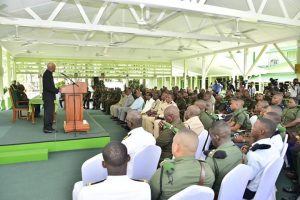

More aircraft, boats for GDF; no place for low endurance soldiers- Granger

President David Granger addressing the opening of the GDF’s 2019 Officers’ Conference.
Commander-in-Chief of the Armed Forces, President David Granger on Thursday announced that the Guyana Defence Force (GDF) would be getting more aircraft, including drones, this year.
Addressing the opening of the GDF’s 2019 Officers’ Conference, he said some of the GYD$14 billion allocated to the GDF this year would be used to purchase “light transport aircraft” as well as drones for border surveillance, inshore patrol vessels and engineering and transport equipment.
Two Britten-Norman Islander planes, he described as “light reconnaissance aircraft” were bought for the GDF last year.
Already, he said the number of GDF military intelligence agents has been increased. “The Intelligence Corps and the Signal Corps have been reformed to enhance intelligence, surveillance and communications. The personnel strength of the Intelligence Corps has been increased. The Signal Corps has benefitted from the acquisition of new radio equipment and personnel training,” he said.
The retired Brigadier declared that soldiers who could not withstand the rigours of long-range exercises deep in the country’s jungle and elsewhere should consider leaving the Guyana Defence Force.
“The GDF was never intended to be a ‘coastal’ force; it is, and will remain, a comprehensive national force. It must reach every corner of the country and must be competent in conducting long-range patrols, in any weather or terrain, by day and night and for long periods.
Officers and soldiers who cannot go on long-range patrols, in any weather or terrain by day or by night, for long periods have no place in the defence force,” he said in an address to the opening of the 2019 Annual GDF Officers’ Conference.
The retired Brigadier the two existing exercises codenamed “Greenheart” and “Ironweed” would be extended and the GDF has been also instructed to prepare ration lists that could last much longer.
Granger said the Engineer Corps has received equipment to enhance the Force’s agility, improve its responsiveness to eliminate climate hazards, promote greater stability within frontline communities and foster defence cooperation.
The Engineer Corps, in 2018, worked alongside the Brazilian Army’s 6º Batalhão de Engenharia de Construção to drill wells in the Rupununi Region in order to build greater climate resilience and provide a regular supply of water for frontline communities.
“I issued a directive for personnel to be brought up to authorised establishment levels, for operational readiness and infrastructure to be improved and for the technical corps to be upgraded and for equipment to be recapitalised,” he added.
He noted that the strength of the Reserve Force named the Guyana People’s Militia has increased from 125 members in January 2015 to nearly 1,500 in January 2019. He added that recruitment “must continue” until it is 50 per cent of the strength of the regular Force.
Officers, defence policy is aimed at The
In the area of youth development, he said the Guyana National Cadet Corps (GNCC), which was resuscitated on 19th January 2018, has trained 364 young persons from six participating schools in five administrative regions.
This Corps’ recruits youth and is aimed at enhancing their skills and leadership abilities, building character and instilling the values and standards of civic responsibility.
Guyana continues to face security threats such as Venezuela’s ongoing claim of the Essequibo Region and its Exclusive Economic Zone as well as from armed Venezuelan gangs called Sindicatos.
Even as theborder controversy remains in the hands of the International Court of Justice, Venezuela’s Navy recently intercepted a seismic research vessel that was gathering data on the Stabroek Block offshore Guyana.
While piracy in Guyanese waters has been suppressed, it is still listed as a threat as is the unsettled dispute with Suriname over the New River Triangle in south-eastern Guyana.

